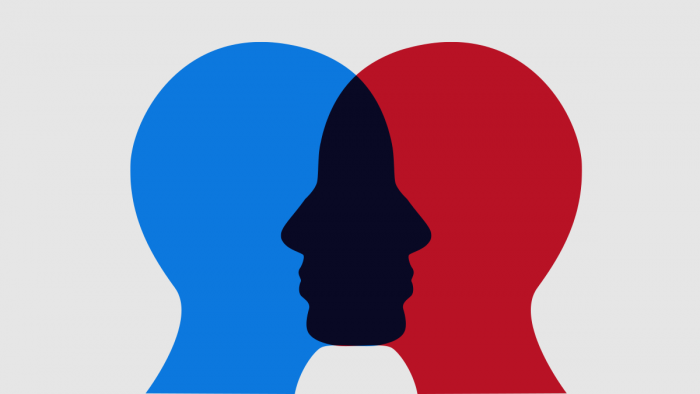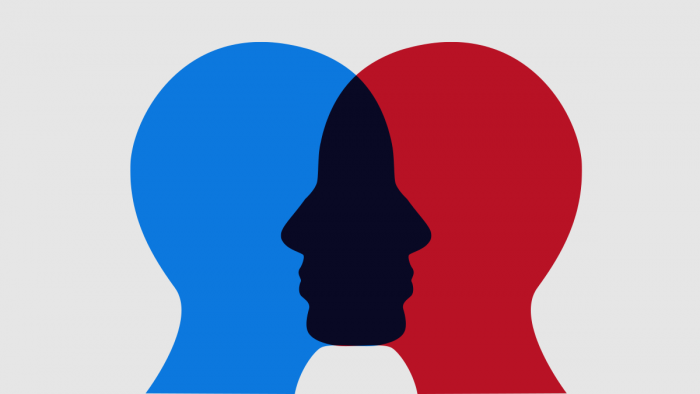Our intense emotional connection with the Israeli hostages needs to be expanded outwards

There is a lot of emotion around. Social media thrives on it, of course. There is no point in sharing something that you are indifferent about or disinterested in. There must be rage, tears, upset, care, concern, love and hate. And there is always plenty of content to get emotional about. If you fail to demonstrate sufficient emotion then perhaps there is something suspect about you, something lacking. Dispassionate engagement is not tolerated. I could be discussing any number of social or political issues online, but I am here talking about the world of pro-Israel, or simply Jewish, social media. I am well aware that there is a parallel phenomenon on pro-Palestinian social media, but here I am focusing on what I see in my community, my world.
Here the emotion is almost entirely focused on the Israeli hostages in Gaza. Copious pictures are posted, particularly of beautiful young women and children of before they were taken hostage. Special attention is paid to the remaining Bibas family hostages, two young children and their mother. These children are longed for, prayed for, loved. Tragically, it seems increasingly likely that they are dead, killed in an Israeli airstrike in the early months of the war, as Hamas said at the time. If they were alive Hamas would surely have freed them in the first wave of releases. It seems to me likely that the Israeli government knows they are dead, and is withholding this information from the public to produce anti-ceasefire sentiment should their deaths be announced. Manufactured or not, the emotional response to these children and their mother is real and deeply felt. There is a strong sense, amongst both Israelis and diaspora Jews that ‘it could have been us, they could have been my children.’ There is a similarly emotive response to the released hostages, especially those who appeared visibly ill on their release. Even those who appeared healthy (there appears to have been great variation in the treatment of the hostages depending where and by who they were held) are seen to be carrying great trauma, which will take a long time to recover from. ‘I don’t believe they are yet free’ I heard one person in synagogue say recently.
I am not an emotionally demonstrative person. I prefer a more detached approach that seeks to protect the rights of everyone, however unappealing or unsuitable they may appear. And I tend to be sceptical of the display of emotions of others, especially when directed towards people they have never met. I am inclined to believe that something else is going on, that people are expressing a trauma in their own lives; a feeling of dissatisfaction with their lives or mourning a loved one. They find an outlet for this emotion in a communally sanctified activity; an issue on which publicly expressing emotions of sadness and loss is valorised by a given community. Talking, or posting emotionally about the hostages within the contemporary Jewish community functions much like this; it is treated as a higher purpose, whereas discussing your personal grief or unhappiness would be discouraged. Where a person might otherwise say ‘I am sad’ or ‘I need help’ they instead say: ‘Bring them Home’.
With this understanding I’m seeking to overcome my scepticism over displays of emotion and appreciate that it arises from a place of genuine personal need. Instead of criticising public proclamations of emotional distress I want to expand their reach. Because many people have been suffering: those Palestinians who have lost swathes of their families, their homes, their schools, their entire communities. Let’s not get into the coarse debate about numbers killed, or what proportion of them were civilians; the point is that there has been massive suffering, and it is a suitable target for our emotional attachment. Going beyond casualties also helps us focus on the huge degree of trauma experienced by those who remain alive. Even if things were to go as well as possible from here on, an unlikely assumption, their trauma will take many generations to heal. They too are not yet free. Let’s also avoid seeing Palestinians as simply mass of people; nameless refugees, fatalities, or worse terrorists. Let’s focus on individual stories; of children, mothers, fathers, grandparents. Most of us can’t get emotional about groups or about numbers. We need individual stories for empathy to occur. The stories ‘of love, life, loss and survival’, with accounts of ‘artists, acrobats, doctors, students, shopkeepers and teachers’ in the recently published collection Daybreak in Gaza would be a good place to start.
It should not be so difficult to engage in this expansion of our empathy, given the similarity between the predicament of many Israelis and Palestinians. There are thousands of Palestinians in Israeli prisoners, most of whom have never been charged with any offence, and thus the majority can thus be considered as political prisoners. Yes, there are convicted killers amongst them, but the constant focus on this minority of prisoners is a tactic of hasbara groups that seek to prevent us building any empathetic connection with incarcerated Palestinians. There are repeated and credible accounts of Palestinian prisoners being tortured and otherwise mistreated in Israeli custody. Many of those released appear clearly unwell and in a vastly worse state to when they were imprisoned; there is a clear connection to the emaciated Israeli hostages released recently. Moreover, there is a broader connection between the hostages and the population of Gaza. Some released hostages were visibly thin and under-nourished, unsurprising when the whole of Gaza, in which they were held, has been under conditions of near famine for sixteen months. The fates of the remaining hostages and Gazans are interlinked: when the latter starve so too do the former. We could further link the population of the Gaza envelope, prevented from returning to the homes by the war with Palestinians prevented from returning to the homes in the North of Gaza until very recently, with many finding them destroyed. There is not a finite amount of empathy; we can emotionally connect to both Palestinian and Israeli victims of this brutal war. The Jewish historian Michael Rothberg has written about multidirectional, as opposed to competitive memory, how the memory of one disaster can shed light on another, without collapsing their differences. Perhaps we can speak of multidirectional empathy; of drawing on the emotional connection we organically feel with members of our own group and using that feeling to try and connect with others with whom our group may be in conflict.
The price of not doing this is high: it means we get things wrong, and this can have fatal consequences. The very strong emotional connection to the hostages felt by many diaspora Jews (and felt rather less organically across the political right in the west) has meant that the captivity of the hostages is seen as the only issue. Absent an emotional connection, the suffering of Palestinians in Gaza and the West Bank, whether killed, injured or ‘merely’ traumatised is discounted or attributed purely to Hamas, even though the bombs and bullets that targeted them were fired by the IDF. And because of this discounting, the January ceasefire agreement is viewed as being wholly about liberating the hostages, and the failure to release them on schedule treated as the only violation that counts. But the agreement covered lots of things; an end to the bombing, the bringing in of aid, the return of Palestinians to their homes in the North of Gaza, and crucially the beginning of negotiations (from the 16th day) for stage 2. The latter promised a permanent ceasefire and a full IDF withdrawal from Gaza, alongside the release of the remaining living Israeli hostages. It was primarily Netanyahu’s delay in opening stage 2 negotiations, coupled with Trump’s appalling ethnic cleansing plan which led Hamas to pause the process, rather than withdraw from it. But those who continue to post on social media only of the suffering of the hostages and demand the immediate release of all of them (which could have happened a long time ago if Israel had agreed to end the war) cannot see any of this. Because of the overpowering emotional connection they feel to fellow Jews (which I respect and merely seek to expand) many of them are wrongly blaming the possible breakdown of the ceasefire process purely on Hamas, and implicitly or explicitly supporting the threatened return to hostilities if ‘all’ hostages are not released on Saturday. Should such renewed warfare occur, many more Palestinians will die, and Israeli hostages along with them, as their fates are interlinked. The failure of the diaspora, and the west more generally, to build an emotional connection with all the victims of the conflict will lead to a situation where yet more blood is spilled.
I know that the obvious conclusion is that to many Israelis and diaspora Jews, Palestinian lives simply count for less than Israeli ones, or do not count at all. I want to resist this conclusion largely because I don’t want to believe that friends and fellow synagogue congregants really think like this. I know that people will argue that it’s ok to care about our own people first, that we need to prioritise the bond Jews have to one another, perhaps referencing the oft-quoted Talmudic maxim Kol Yisrael Arevim Zeh Bazeh – all Israel are responsible for one another (Masechet Shavuot 39a). But as is often the case this quote has been taken out of context and its meaning drastically changed. The Talmud text is about a court setting, specifically about false oaths. The phrase here means that if one Israelite sins, all Israel, i.e. all the Jewish people, is held responsible for that. It has nothing to do with ethno-nationalist solidarity. It may be the case that many Jews only care about other Jews, but that doesn’t make it a Jewish value. We need to reinstate a Jewish ethic of broader care; especially for people who are suffering at the hands of a supposedly Jewish army and Jewish government. We have to reinstate Ben Azzai’s insight – that the fundamental Jewish teaching is that we are all the children of Adam, that if you go back far enough we are all one people.
Synagogues have grown accustomed to the display of pictures of hostages in their sanctuaries, and praying for their release. The pictures of those who have been released will presumably be taken down, perhaps replaced by those who are still held captive. But if, by some miracle, the deal is seen through all the stages, and all hostages are released, both alive and dead I suspect there will be demands for some kind of ongoing memorial in our synagogues. A shrine to the hostages who died perhaps, or certain prayers permanently added to the liturgy. There will be a temptation for those of us in the anti-war camp to oppose this, or at least to point out the significant culpability of the Netanyahu government in their deaths. But I think we would do better to call for the memorial to be expanded, to include the Palestinians killed in Gaza, in the West Bank or in Israeli prisons. We should call for their names and faces to be remembered, just as the deceased hostages will be. They are victims of the same war and deserve to be remembered alongside each other. We would be remembering Israelis killed and those killed by Israel in the same space. Such a multidirectional memorial would be a worthy target for our emotions.

